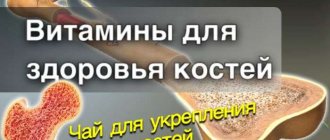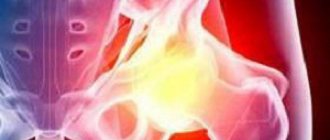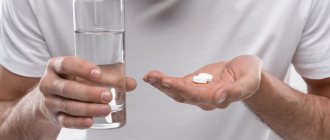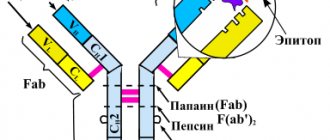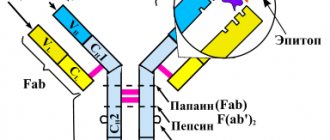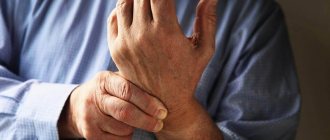Causes of Dupuytren's contracture
In 1832, the French surgeon J. Dupuytren, while dissecting a hand with contractures of the fingers, discovered pathological changes in the palmar aponeurosis, which he described as follows: “Having isolated the palmar fascia, I was amazed at how shortened, tense and retracted it was.
Strands extend from the lower part of the fascia to the affected fingers. I cut the growths that went from the fascia to the fingers, and the contracture immediately disappeared. I carefully examined the tendons - their surface was smooth, they retained their mobility, the joints were also healthy.” After the publication of Dupuytren's scientific works, this disease was named Dupuytren's contracture, which, relative to other diseases of the musculoskeletal system, is diagnosed in 1.5-2% of patients, mainly men aged 40-60 years.
The cause of Dupuytren's contracture remains unclear. There are several theories about the appearance of contracture:
- traumatic,
- fibroblastic,
- endocrine,
- constitutional,
- hereditary
- neurogenic,
- others, less significant.
At the same time, none of them provides a comprehensive explanation of the pathogenesis of the disease.
Today, Dupuytren's contracture is considered a systemic disease of connective tissue, as evidenced by similar fibrotic changes in the plantar aponeurosis (Ledderhose disease) and on the dorsal surface of the penis (Peyronie's disease).
The palmar aponeurosis (fascia) is a dense plate of connective tissue of a triangular shape, its base directed to the head of the II-V metacarpal bones, and its apex passes into the narrow tendon of the palmaris longus muscle. In the absence of this muscle, the apex of the palmar aponeurosis merges with the holder of the flexor muscles and is covered on top by a thin layer of adipose tissue. The palmar aponeurosis consists of longitudinal and transverse bundles. Longitudinal bundles are concentrated over the tendons of the flexor muscles of the II-V fingers, forming pretendinous bands that pass to the palmar and lateral surfaces of the fingers, fuse with the skin and walls of the osteo-fibrous canal of the fingers. The transverse bundles form a wide layer of the aponeurosis, which has the appearance of a braid, and support the arches of the metacarpus.
The palmar aponeurosis, with the help of fibers, is closely connected with the skeleton of the hand, rich in sensory nerve endings, and is the place of origin of afferent impulses. Tension and relaxation of the palmar aponeurosis under the influence of the long and short palmar muscles cause a slight suction effect and promote local blood and lymph flow.
Dupuytren's contracture can affect two or three fingers on one, or more often, both hands.
In the clinical course of Dupuytren's contracture, there are four stages, the most common of which are the first three:
- Stage I is characterized by the appearance in the palmar aponeurosis of isolated seals not fused to the skin in the form of nodules or cords, painful on palpation. The function of the hand is not impaired, but hyperextension in the metacarpophalangeal joint of the affected finger is lost.
- Stage II is characterized by an increase and fusion of nodules, cords that adhere to the skin of the palm, in the folds of which a certain involvement is formed. The skin over the aponeurosis nodes becomes rough and loses mobility. In the metacarpophalangeal joints, the flexural contracture reaches 150°. Hand dysfunction occurs.
- At stage III, a dense scar conglomerate appears in the palmar aponeurosis, fused to the skin along its entire length, with the presence of deep retracted skin. Fibrous nodes appear on the palmar surface of the main phalanges of the fingers. Diaper rash occurs in deep depressions of the skin. Flexural contracture in the metacarpophalangeal joints is estimated at 150-120°, and in the first interphalangeal joints - up to 150°. The functional ability of the hand is significantly impaired, cylindrical and layer-by-layer grip is lost.
- Stage IV is characterized by massive dense scar conglomerates not only on the palmar surface of the hand, but also on the main phalanges. The skin becomes motionless, with deep retractions. The fingers are bent at the metacarpophalangeal and proximal interphalangeal joints at an angle of 90° with hyperextension of the nail phalanges. The function of the hand is significantly impaired when the first finger is involved in the pathological process.
How to treat Dupuytren's contracture?
More often, patients seek medical help late, that is, in the event of significant contractures with impaired hand function. Therefore, conservative treatment is not always effective.
In the early stages, injections of plasmol, vitreous humor, papain, applications of sage, ozokerite, paraffin, acupuncture are performed, and mud therapy is prescribed, which makes it possible to delay the progression of contractures, but for a short time. In some cases, injections of furazolidone solution are used to treat Dupuytren's contractures. The solution must infiltrate the entire scar conglomerate. The course of treatment consists of 3-5 injections with an interval of 12-14 days.
In the early stages (I-II), the aponeurosis nodules decrease and contractures do not progress. After infiltration of the fibrous conglomerate of the aponeurosis, compresses are prescribed with a 30-40% dimexide solution, after lubricating the skin with heparin and hydrocortisone ointments, sprinkle with furazolidone powder (2-3 tablets are ground). Infiltration with furazolidone solution is also done in the later stages of the disease (as preparation for surgery). By infiltration with a solution of furazolidone, it is possible to soften skin adhesions with fibrous conglomerate and separate the skin from the scar-degenerated aponeurosis.
Surgical treatment is indicated in the later stages and consists of complete excision of the fibrous-degenerated palmar aponeurosis.
In case of old contractures of the fingers, to eliminate them, the wrinkled capsule of the metacarpophalangeal and first interphalangeal joints is additionally cut out along the volar surface. In case of joint stiffness, in order to eliminate phalanx contracture, it is necessary to perform arthroplastic resection of the interphalangeal joints.
Is it possible to treat varicocele without surgery?
By searching for “varicocele medication treatment” you will find many options for getting rid of this disease using conservative methods. However, their use can only be effective in the first two stages. In this case, drug therapy must be combined with:
- Giving up bad habits.
- Moderate physical activity, avoiding carrying heavy objects.
- A special diet excluding smoked, salted, fried and fatty foods.
If stage 1 or 2 varicocele is diagnosed in adolescence, then you can do without surgery using only medications, lifestyle and nutrition changes. Tablets for varicocele in men help to restrain further expansion of veins. The same rules apply to elderly patients - they can also do without surgery.
How to cure varicocele without surgery? To do this, you can use traditional medicine - infusions, decoctions, compresses. The basic rule is the absence of individual intolerance to the components. You can resort to homeopathic remedies that improve the condition of blood vessels, blood flow, and increase immunity.
How to treat varicocele without surgery using tablets? In this case, drugs are prescribed only by a doctor. However, for varicocele in men, conservative treatment is effective only under certain conditions. In most cases, surgery is necessary; without it, full recovery is impossible.
What diseases can it be associated with?
In the metacarpophalangeal and first interphalangeal joints with Dupuytren's contracture, due to the constant forced bending position and limited movement, the joint capsule is affected by a significant scarring process. Joint rigidity is detected, which prevents the restoration of movement function after surgical treatment of contracture.
Dupuytren's contracture is always characterized by a progressive course. In some cases, the process occurs gradually, stretching out for 5 years or more. It happens when contracture proceeds malignantly - then all stages of the pathological process replace each other, reaching the fourth stage within a year.
Treatment of Dupuytren's contracture at home
Conservative treatment of Dupuytren's contracture does not require hospitalization. Most often, outpatient treatment is used or the patient is recommended to visit medical institutions to perform specific procedures. The patient can carry out most of what is prescribed by the doctor independently at home.
If a patient is scheduled for surgery, the operation is most often performed in a day hospital by a surgeon of the appropriate specialization.
Causes of the disease and statistics
The reasons that lead to the development of pathology are still not fully understood. There are theories in favor of traumatic, neurogenic and hereditary genesis of the disease. Patients often have blood relatives who also suffer from palmar fibromatosis.
According to statistics, Dupuytren's contracture most often occurs in middle-aged men. In 50% of cases, bilateral palmar tendon damage occurs. The ring and little fingers are most commonly affected.
Treatment of Dupuytren's contracture during pregnancy
Dupuytren's contracture rarely develops in women, especially those of reproductive age. According to medical statistics, the disease is more common among mature and elderly men.
If the disease does occur in a pregnant woman, then the treatment strategy should not differ from the generally accepted one. The attending physician will certainly be notified of the woman’s situation; conservative therapy will certainly be composed of those medications that will not harm either the expectant mother or the fetus.
If possible, treatment can be postponed until after childbirth, since the disease does not always progress over years, or even a few months.
When is conservative treatment ineffective?
Surgery is the main method of treating varicocele. It is this that will help get rid of varicose veins and return a man to a normal lifestyle. The operation is necessary in the following cases:
- If there is pain in the testicular area.
- If the testicle has decreased in size.
- In the presence of pathological changes in sperm.
Conservative treatment will only help improve blood flow and reduce inflammation in the first stage of development. But surgery will still be required.
At the moment, several types of operations are offered. Microsurgical is considered the most effective - after such an intervention, the rehabilitation period is significantly reduced. However, only a doctor can choose the most optimal option. The following factors are taken into account:
- General health of the patient.
- Age.
- Stage of development of the disease.
- Features of the body's vascular system.
The operation allows you to restore normal blood flow in the testicles and restore spermatogenesis. As a result, discomfort and pain disappear, and the man can lead a normal sex life. However, after the operation there will also be a period of rehabilitation, during which you must follow the recommendations of your attending physician.
Which doctors should you contact if you have Dupuytren's contracture?
Clinical diagnosis of Dupuytren's contracture is not difficult. On the palmar surface, often above the V or IV metacarpal bone, a dense subcutaneous nodule the size of a pea appears, painless on palpation, not mobile, not fused to the skin. Much less often, such nodules are observed in the area of the III, II or I metacarpal bones.
The nodule gradually enlarges or new ones appear, which eventually merge into one conglomerate; the skin over the fibrous nodules gradually loses its mobility and organically fuses with them. Later, similar fibrous compactions appear on the palmar surface of the main phalanges.
At first, the function of the fingers does not suffer from the appearance of nodules, only hyperextension in the metacarpophalangeal joints disappears. Subsequently, with increasing retraction of fibrous nodules, flexion contractures form in the metacarpophalangeal joints, and over time, in the first interphalangeal joints with impaired hand function. Significant depressions and diaper rash form in the folds of the skin.
Due to the fact that the fascial bundles of the palmar aponeurosis do not reach the nail phalanges, flexural contracture does not occur, and with flexion contracture of the main and middle phalanges up to 100-90°, the nail phalanges rest against the array of muscles of the eminence of the thumb and are pushed towards the dorsal surface, which leads to their hyperextension.
With Dupuytren's contracture, histological studies in the palmar aponeurosis show pronounced dysplastic changes with the proliferation of fibroblasts, the formation of collagen fibers, and the formation of a dense scar cord instead of an elastic sheet.
Flexion contracture of the fingers
Flexion contracture of the fingers, depending on the location of the cord, can be classified as:
- palmar;
- finger;
- finger-palm.
According to the degree of limitation of finger contracture, the Tubian classification is used:
- first degree, finger flexion up to 30 degrees;
- second degree - up to 70 degrees;
- third degree - up to 90 degrees;
- fourth degree – up to 135 degrees.
The peculiarity of this pathology is that both hands are more often affected. The clinical picture is typical: the hand loses its function, and over time, bedsores, inflammation and maceration of the skin appear.
In young people, contracture has a more malignant course and can develop over 3-5 years.
Treatment of other diseases starting with the letter - k
| Treatment of campylobacteriosis |
| Treatment of skin candidiasis |
| Cough treatment |
| Treatment of lung cysts |
| Treatment of liver cysts |
| Treatment of pancreatic cyst |
| Treatment of splenic cyst |
| Treatment of ovarian cyst |
| Treatment of cluster headaches |
| Treatment of tick-borne encephalitis |
| Treatment of menopause |
| Treatment of colitis |
| Treatment of colpitis |
| Treatment of molluscum contagiosum |
| Treatment of conjunctivitis |
| Treatment of measles |
| Treatment of osteoarticular tuberculosis |
| Treatment of urticaria |
| Treatment of lichen planus |
| Treatment of rubella |
| Treatment of cryptorchidism |
| Treatment of Q fever |
The information is for educational purposes only. Do not self-medicate; For all questions regarding the definition of the disease and methods of its treatment, consult your doctor. EUROLAB is not responsible for the consequences caused by the use of information posted on the portal.

